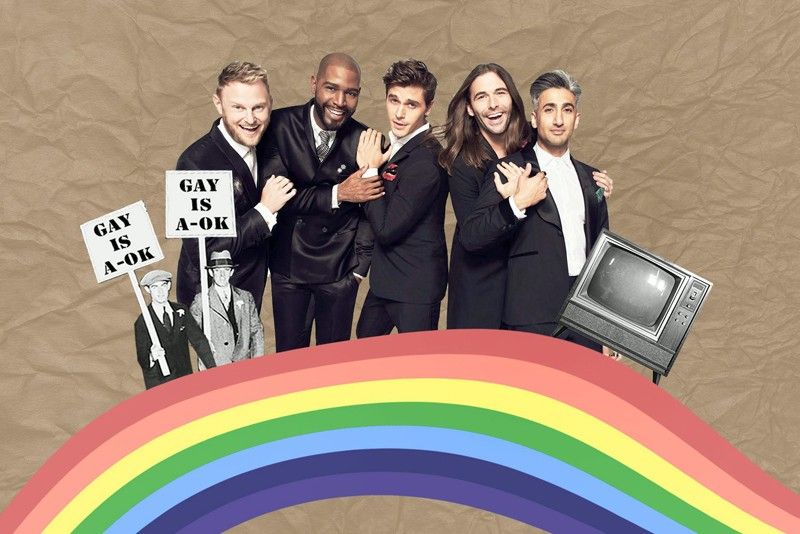Still here, still queer

Over the rainbow: The reboot of Queer Eye is the series that we didn't know we needed in 2018. Art by Neal P. Corpus
In his column's debut, Neal P. Corpus talks about how Netflix’s reboot of ‘Queer Eye’ makes strides towards getting what we really want: acceptance.
When I was growing up, the only gay people I knew were hairdressers and manicurists from mom’s trips to the salon. And for the longest time, gay people were relegated to that corner, only being tolerated because they were good at what they did: making the world a prettier place. In a way, the original Queer Eye reflected what those times were about: tolerance. But things are a bit different now, and you can find openly gay people in pretty much every industry, which is a good thing. But there’s still quite a ways to go to really claim our place in the world. The 2018 reboot by Netflix, which features Antoni Porowski, Tan France, Jonathan Van Ness, Bobby Berk and Karamo Brown as the new Fab Five, does that and then some, tackling topics like racial profiling, growing up in extremely religious and homophobic communities, being afraid of being too effeminate — and the list goes on.
I’ll admit that I didn’t get to see the original series, and I had to find out about the new Queer Eye from a straight guy of all people. But I’m glad that this year’s version proves that being gay doesn’t mean being boxed into industries concerned with our outward appearance. It took me until college to realize that being gay doesn't mean you’re all into the same things, and that being gay just means being who you are. The 2018 Queer Eye gets this across to an even wider audience. As fashion guru Tan says in the first episode, “The original show was fighting for tolerance. Our fight is for acceptance.”
One episode that stood out to me was “To Gay or Not Too Gay,” which featured AJ, a gay guy who has more of a conservative personal style and is afraid of being perceived as too gay or effeminate because of his job. What makes this episode is really the moment when he comes out to his stepmom by reading a letter he wrote to his late father (whom he did not get to come out to), which, I guarantee you, will make you cry more rivers than Justin Timberlake. But that’s not the point. Pre-makeover AJ is boring because he’s deathly afraid of being stereotyped into an early-2000s caricature of a “gay guy.” Listen, I know that not every gay guy is gonna be into fashion and grooming and interiors and good food. Still, that doesn’t mean that you can’t be comfortable with who you really are just because of what you do for a living. The Fab Five assure him that it’s totally fine to be a strong, black gay man who’s also a leather daddy (he’s so hot, guys).
While Queer Eye covered a lot of ground, the show could have made bigger strides for the LGBT community as a whole, but they could only talk about so much given the paltry eight-episode season. It's definitely a step in the right direction, but if there was anything I could have added, it would be the affirmation that it's also okay to be effeminate as opposed to being hypermasculine, and that being "girly" does not equate to being weak. It's this kind of misogyny that still pervades the gay community — especially here in the Philippines — but that's another topic that needs to be unpacked on its own.
It was also a missed opportunity to really get into the nitty-gritty of issues in the gay community, and to really tell The Straights™ about what gay people are going through. For example, in the episode “Dega Don’t,” even if Karamo has a heart-to-heart with Cory, the cop they’re making over, about the tension between the police and African-Americans, they don’t dig into the fact that he’s also a Trump supporter.
Word of a second season seems positive, and honestly, once you’ve finished binge-watching the season, you’re going to want more. What makes Queer Eye so watchable is a good balance of fluff and substance throughout, and you almost don’t realize that you’re learning something — about style and where gay people stand in the world today. It’s going to take a lot of work — as with all things worth changing — but Queer Eye has the platform to make a real difference, and my hope is that they use that to its full potential. Because being gay isn’t just about being fabulous and well-dressed, and it’s time that the world comes around to accept that.















